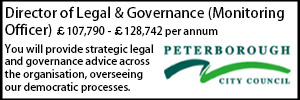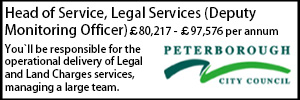The Office for Environmental Protection and local authorities
What are the recommendations of the OEP’s report Environmental Inspections in England (July 2025) and should local authorities feel the heat? Gordon Wignall looks at the implications for councils.
- Details
This article concerns the OEP’s recent report on inspections carried out by environmental regulators. The OEP selected two areas in which local authorities hold such duties and it made eight recommendations. Local authorities, as well as other environmental regulators, need to ask themselves whether they need to be wary about the direction of the Report.
The Office for Environmental Protection
The OEP was created as a legal body on 17 November 2021 under the Environment Act 2021. It has two principal statutory objectives in England: to contribute to environmental protection and the improvement of the natural environment. It is guided by a “mission” and four strategic objectives within its 68-page Strategy. It can carry out investigations, either as a result either of a complaint or of its own motion and it has enforcement powers in relation to serious failures by public authorities.
Since its founding, the activity of the OEP has been breathless. It lists 223 reports and publications on its website and 26 investigations and interventions.
Inspections by environmental regulators
As the OEP observed in the Report, “oversight of inspections has traditionally received little scrutiny”, the issue of inspections having played an increasing part in environmental reviews. See for instance the 2005 Hampton Review (Reducing Administrative Burdens), the 2023 National Audit Office (Regulating to achieve Environment Outcomes), the 2024 House of Lords Committee (Who watches the Watchdogs) and the 2025 Corry Review (An independent review of Defra’s regulatory landscape, published in April).
Of these various reviews, the OEP Report makes frequent reference to the Corry Review (with 29 recommendations), two of the main themes of which are that: (i) it can be inappropriate to have enforcement standards fixed by reference to defined standards rather than outcomes for the environment, and (ii) environmental performance might better be assessed by the ‘constrained discretion’ of regulators. The Corry Review has a decidedly growth agenda.
Drawing on the conclusions of the above, on 10 July, the OEP published its 204-page document. It is unclear from the Report itself what definitive resolution led the OEP to carry out its research. Local authorities are not the only regulatory subject-matter under the microscope.
Case studies
In order to examine how inspections are dealt with by regulators, OEP reviewed 198 environmental laws, of which there was a “diverse range of statutory approaches” and selected 10 regulatory case studies.
Quite why these 10 laws were selected is also unclear, but the authors concluded (after examining the sample cases), that “the overall message that we drew from these findings is that, in England, the majority of environmental laws do not address inspection. Where they do, the majority are highly discretionary about the inspection approaches and outcomes that they expect and require”.
The authors were not just concerned with the risk of poor environmental compliance, but also with the consequences for operators: “having wide, legislatively backed discretion can make it harder for third parties to understand and anticipate regulators’ approaches. It also makes it harder for regulators to be held to account should they not be adequately monitoring and enforcing compliance with environmental regulations”.
They also noted that where an inspection regime was unclear or placed a wide discretion on the operator, a Court on a judicial review was likely to defer to the regulator, an outcome which OEP did not consider altogether acceptable: “Administrative discretion needs to be confined, structured and checked”. (See the judgments in R (oao Wild Justice) v The Water Services Regulation Authority (2023) and R (oao of River Action UK) v Environment Agency (2024).
Turning to the inspection regimes of local authorities, the OEP selected the statutory nuisance regime and the regulation of small burners. Two other case study areas falling within the Environmental Permitting Regulations 2016 were chosen, namely the T11 waste exemption and paper and textiles (the relevant agency being the Environment Agency), two further regulatory areas monitored by the EA, namely water and abstraction licences and bathing water), and four additional areas regulated by four other bodies, namely the HSE, the Fish Health Inspectorate, the Marine Management Organisation and APHA.
None of the case studies involved individual on-the-ground inspections. The OEP’s assessments were made by what might be described as desk-top investigations, in which the regulators in question were asked for various categories of information.
Since the readership of the Local Government Lawyer will no doubt be interested in what other authorities are up to, an account is called for as to the information disclosed by the two sample sections which may concern them (see Annex 3).
Statutory nuisance
The OEP decided to investigate the two duties falling within s.79(1), Environmental Protection Act 1990, namely the duty on authorities “to inspect their area from time to time” for any statutory nuisance” and the duty “to take such steps as are reasonably practicable to investigate” should a complaint of statutory nuisance is made by a person living within its area”.
Surprisingly little was done to review the existing law relating to these duties. As to the former, there is no reference to para.4, Schedule 3, which arguably provides the only remedies available for non-compliance (default powers on the part of the Secretary of State). As to the latter, there is no discussion as to the effect of Jordan v. Norfolk County Council [1994] 4 All ER 218 and the conclusion that financial considerations are relevant to the test of reasonable practicability, which is odd, since the Report is interested, in part, as to whether a ‘risk-based’ approach to inspection might have been replaced by a ‘resource-based’ approach. Neither is there any examination of the various reports of the Local Government and Social Care Ombudsman.
Perhaps the authors thought that there was little need to examine such law as can be found. The OEP received 195 responses requesting information about authorities’ approach to their duties, a quarter of whom informed the OEP that they carried out no inspections at all. 77% per cent reported that they conducted “some form of activity”, and the answers from the 17% which did provide figures, varied widely from two to a thousand inspections annually.
The written answers from local authorities were instructive, some of whom described inspections as “inefficient”, "extraordinary low value for money” and “dated”. Many inspections were carried out alongside the execution of other duties.
65 authorities provided data sets as to the number of complaints they received: 34% resulted in a site visit.
The OEP interrogated the respondent local authorities’ Revenue Outturn forms for the year 2023/4. In respect of “Environmental protection; noise and nuisance”, total expenditure of 258 authorities came to £244,254,000. Income (from fees and charges) came to £57,044,000. 241 authorities spent more than they received, the average overspend being £785,000.
Small waste incineration plants
Local authorities’ regulation of small waste incinerators plans falls under the Environmental Permitting Regulations 2016 and the LAPPC regime. There is a duty to inspect as well as to review a permit (reg.34(1) and (2)). (The OEP selected three other areas for consideration which are governed by the EPR.)
As to documents which might insist with such inspections and reviews, the Core Guidance is relevant to the inspection of permitted waste plants (revised 2020) and the more granular General Guidance Manual also applies (revised 2012) which contains a requirement to ensure a “risk-based’ approach and a summary of the number of hours which may be required per inspection.
The OEP received 68 responses from local authorities, covering 110 permits. 18 permitted sites received no inspection in the year under consideration, levels of perceived risk being the main driver behind the frequency of inspection. Whilst self-monitoring data was provided by operators, it seemed unlikely that it was being reviewed by authorities. The OEP’s main concerns in respect of small waste incinerator plants were the fact that Guidance is out-of-date, and that DEFRA’s annual ‘Local Pollution Control Statistical Survey’, which had contained an “impressive” amount of information, was no longer being published.
From the information provided, the OEP concluded that the current permitted fee charging scheme did not cover councils’ costs, especially for lor-risk facilities. As to ‘transparency’: “there is very little information to indicate what inspections or other compliance activities are taking place in practice and how effective they are” (p.126).
The recommendations
The authors of the Report made the following recommendations:
(1) DEFRA and other government departments should review and update guidance. This is for the general benefit of both regulators and the public.
(2) Details of inspections undertaken should be published on publicly available registers (in compliance with para.6(2)(c), Regulators’ Code). This is to ensure accountability of regulators and efficiency and effectiveness.
(3) Regulators should publish their inspection criteria in a standalone document such as a ‘compliance monitoring policy’ in order to assist with (2) above.
(4) DEFRA should review whether risk-based regulation is being implemented to ensure that inspection regimes are not simply ‘resource-constrained’.
(5) More data should be published by regulators as to the cost of inspections and how they are financed (the current position being unclear). The current lack of clarity makes it difficult to identify inefficiencies and areas for change.
(6) DEFRA should ensure that Post-Implementation Reviews of environmental laws (PIRs) evaluate the effectiveness of inspections.
(7) DEFRA should periodically review and publish its conclusions as to the practice and adequacy of inspections. There needs to be “oversight to the overall inspections landscape”. This will enable whether regulation is “achieving results”.
(8) DEFRA should research and publish its conclusions as to the influence of inspections on environmental performance and environmental risk. This is because it would be “beneficial for there to be research which provides objective … evidence of the influence of modern regulation”.
Considerations for local authorities
It is not being over-critical of the OEP to raise eyebrows at its recommendations, given that there is no caveat that government needs first to establish exactly what its environmental outcomes are intended to be. For instance, how can guidance or inspection criteria be published or updated, if it is unknown whether the recommendations of the Corry Review are to be accepted across the board, that for the purpose of growth, regulators should be allowed a “constrained discretion” to ensure the achievement of overall environmental outcomes, rather than specific targets?
From the point of view of local authorities, the recommendations look broad-brush. The inspections regimes and aims of the statutory nuisance regime are very different, for instance, from those of the EPR 2016. On the other hand, it could be useful if published data make clear the inadequacies of current funding regimes especially since the suggestion has been mooted that a regulator may be permitted to use different budgets to fund their inspection regimes.
Finally, however, local authorities would surely be well advised to examine those legal areas where they can at least retain and preferably publish data and update current enforcement policies in order to acknowledge those recommendations which are not restricted to the role of DEFRA. The OEP’s Strategy reflects the Aarhus treaty, the Convention on Access to Information, Public Participation … and Access to Justice in Environmental Matters. Following its recommendations, there will be others, not just the OEP, who will expect to find and interrogate inspection data.
Gordon Wignall is a barrister in private practice who maintains a website, wiglaw, which provides information about the law of nuisance, including statutory nuisance and related issues relevant to local authorities.
Senior Lawyer - Contracts & Commercial
Contracts & Procurement Lawyer
Trust Solicitor (Employment & Contract Law)
Lawyer - Property
Locums
Poll







































